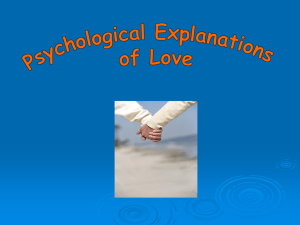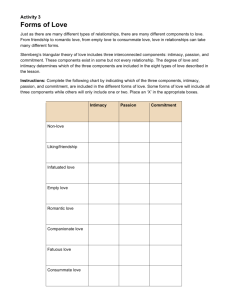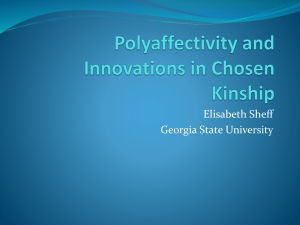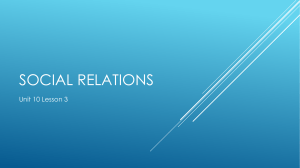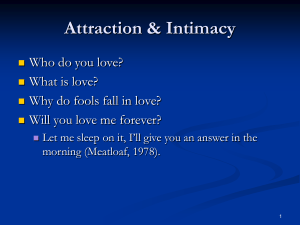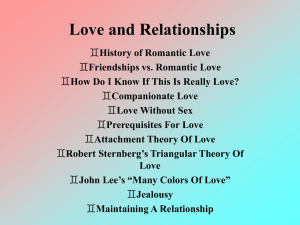Developing and Enriching Intimate Relationships
advertisement
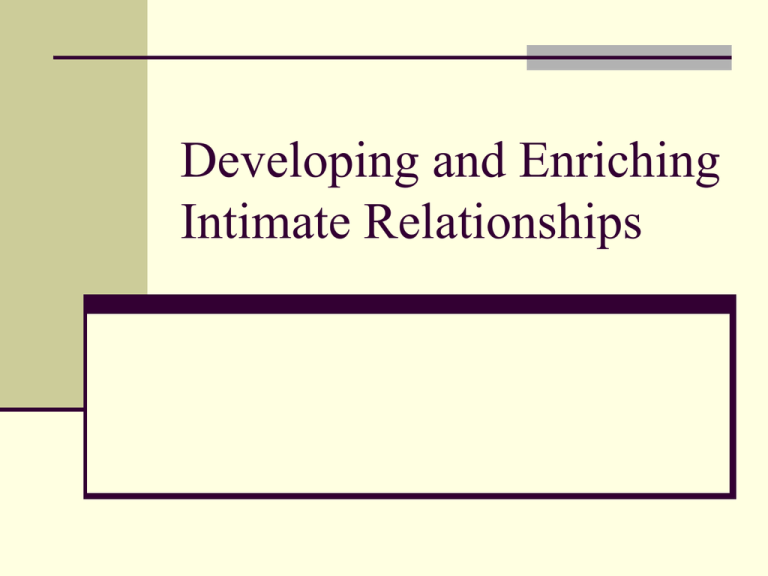
Developing and Enriching Intimate Relationships Obstacles to Love Low Self-Esteem If I can’t love me then how can I trust another who says that they love me. (Cycle) Extensive Giving and Addiction Better stated as “giving up your individuality” Society focuses on obsessive and violent love Love “Liking with great emotional intensity Falling in Love Heightened physical arousal Increased emotionality Frequent thoughts of the loved one Love Grows or Fall in Love Romantic Attachment: Individual Differences Attachment Styles Secure 54% (comfortable with intimacy & interdependence) Avoidant 25% (dislike dependency and closeness) Anxious/Ambivalent 19% (clingy & possessive, seeking assurance from partner) Bartholomew’s Four Categories of Attachment Style Secure Preoccupied (I want complete intimacy but I feel that others are reluctant to get as close to me) Fearful (I am uncomfortable getting close to others. I want to get close but I find it difficult to trust or depend on them) Dismissing (I am comfortable without close emotional relationships but prefers not to depend on others) Outcomes of Attachment Styles Secure- report greatest enjoyment, intimacy , and positive emotions, higher levels of disclosure & relational problem solving Anxious/Ambivalent- more changeable emotionally Avoidant- lower levels of positive emotions and appear to structure social activities in a way that minimizes closeness (Tidwell et al. 1996) Secure and Insecure show comparable overall degrees of security Three General Theories of Love Evolutionary Psychological Theory of Love Primitive Emotional Bonding to Promote Race Buss (1988) Love Acts Social Structural and Social Learning Theory Love is Learned from Observation and Socialization Self Expansion Theory Premise: We seek to grow and expand self through the incorporation of people, experiences, and possessions into one’s conception of self Idea is to become united with universe not self aggrandize. Theories of Love II Consider the Following Using the 3 General Theories Passionate Love Companionate Love Prototypical Approach Considers the most representative features of love Caring, friendship, honesty, trust, and respect Sex, passion, novelty Love Schema Mental model consisting of expectations and attitudes about love. Six Love Schemas Secure- closeness and independence Clingy- high level of closeness Skittish- uneasy with closeness Fickle- never satisfied with present relationship Casual- enjoys relationships without committing Uninterested- not interested in any relationship History of Love Four Dimensions of Attitudes about Love Cultural Value: Is love a desirable state? Sexuality: Should love be sexual or unsexual? Sexual Orientation: Should love involve homosexual or heterosexual partners? Marital Status: Should we love our spouses or is love reserved for others? Historical Views of Love Love is madness Love has little to do with marriage Love need not involve sexual contact Love is a noble quest Love is doomed Love can be happy and fulfilling Love and marriage go together. Types of Love Robert Sternberg’s Triangular Theory of Love Intimacy- feelings of warmth, support and sharing Passion- physical arousal and desire Commitment- decision to devote oneself to a relationship Intimacy Passion Commitment Nonlove Low Low Low Liking High Low Low Infatuation Low High Low Empty Low Low High Romantic High High Low Companionate High Low High Fatuous Low High High Consummate High High High Romantic, Passionate Love “I love you, but I’m not in love with you” According to Berscheid, Passion is Rooted in: 1) physiological arousal 2) the belief that another person is the cause of the arousal Misattributions (excitation transfer) Laughter Fear Exercise Romantic, Passionate Love Thoughts The more you love the more you will think about them (reverse) Romance blinds to undesirable traits Thoughts about ourselves change when we are in love Romantic lovers state that they would do anything for their partner and that they would be miserable without them. Love and Age People married for five years were less romantic than high school seniors People who had been married for 20 years or more were the most romantic of all. Link between romance and age is a wide and shallow mouthed U. Companionate Love Two major types of love that occur in American marriages Love full of passion that leads people to marry Love that’s full of friendship that underlies marriages that last. Styles of Loving Eros- Erotic lover focuses on physical appearance Ludus- Playful in love and likes to play the field Storge- Slow developing attachments with commitment Mania- Demanding and possessive, has a feeling of being out of control Agape- Altruistic, loving without concern for receiving anything in return Pragma- searches for a person with proper vital statistics Men higher on ludus whereas women are more storgic and pragmatic Ingredients of Love: Needs from Love Carlton Paine’s Ingredients of Love Trust (honesty and dependability) Affection (fondness for each other) Respect (admiration and regard) Fulfillment of Love Needs Important to Match in Beginning Communicate needs openly Observe your partner with others Be willing to make changes in self Don’t assume the person will change in marriage Love Behaviors “She loves me because she will do anything I want” “If you love me you would know what I want” Autonomy/Independence Closeness Forgiveness Honesty Respect Others? Love and Sex More similarity than differences between sexes Women tend to experience stronger emotions than men do; on average, women’s emotions are more intense and more volatile. Studies rarely find differences in romantic love between the sexes. More men believe in love at first sight and that if you just love someone enough nothing else matters. Women are more cautious about love, more selective and passion develops more slowly Does Love Last Prototypical North American Marriage Romantic love with pledge of entire life Romantic love decreases after people marry Why doesn’t it last? Fantasy- love is blind Novelty- excitement Arousal- fades or habituates INTIMACY IS MORE STABLE THAN PASSION COMPANIONATE LOVE IS MORE STABLE THAN ROMANTIC LOVE Intimacy Intimacy- “emotional closeness”: to really know another Key Elements (Sternberg, 1987) Promote each others welfare Experience happiness together Holding each other in high regard Counting on each other in times of need Mutual understanding Sharing of self and possessions Receiving emotional support Giving emotional support Communicating intimately Valuing each other Intimacy Development Eliminate Blockers Withdrawal or isolating the self (work, etc) Personal Rigidity (no compromise) Overt Self Righteousness (need to be right) Lack of Trustworthiness “We can only be intimate to the degree that we are willing to be open and vulnerable (Ornish, 1998) Intimacy Development Enhancers Androgynous Personalities Expression of Genuine Emotions Empathic and Nurturing Behaviors Paying Attention to Others Mutually Enjoyable Activities Communication (especially deep selfdisclosure) Commitment Enriching a Relationship Compliment not Criticize (5:1 ratio) Be curious Be honest (no secrets) Plan together Be spontaneous Develop traditions Talk about individual and shared interests Enriching a Relationship Spend Time Together Be Appreciative Five Positives to Every One Criticism Communicate (honesty & curiosity) Demonstrate Affection Be Spontaneous Develop Rituals
